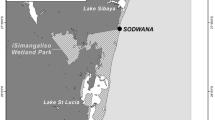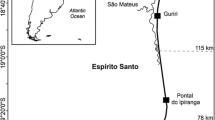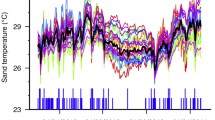Abstract
Leatherback sea turtles (Dermochelys coriacea) are hypothesized to be capital breeders, whereby they forage little to none during the nesting season. The capital breeding hypothesis can be tested in marine turtles using physiological measures of health, which are much less expensive than studies that use satellite tags or other physiological monitoring equipment to make inferences about behavior and foraging status during the nesting season. In this study, we analyzed packed cell volumes (PCVs), a simple and inexpensive, hematologic health parameter, in nesting leatherback turtles from St. Croix, U.S. Virgin Islands (17°40′40″N, 64°54′0″W) across the nesting season (April–July 2009) in an effort to determine foraging status. We found that PCV in nesting females significantly declined using two longitudinal measures: nest number and level of reproductive effort. We also found that PCVs of remigrants were significantly higher in comparison with neophytes, suggesting that experience in reproductive activities (e.g., migration, breeding, nesting) might increase foraging success on feeding grounds. Lastly, we found that leatherbacks with a greater reproductive output had significantly higher PCVs. While the northwest Atlantic leatherback population is evaluated as least concern by the IUCN, Pacific leatherbacks are critically endangered. The assumed behaviors of turtles from this study provide insight into reproductive strategies and energy reserves in all marine turtle populations. Thus, the results presented here are applicable to (1) veterinarians, rehabilitation facilities, and conservationists and (2) other more vulnerable marine turtle populations.




Similar content being viewed by others
References
Bailey H, Benson SR, Shillinger GL, Bograd SJ, Dutton PH, Eckert SA, Morreale SJ, Paladino FV, Eguchi T, Foley DG, Block BA, Piedra R, Hitipeuw C, Tapilatu RF, Spotila JR (2012) Identification of distinct movement patterns in Pacific leatherback turtle populations influenced by ocean conditions. Ecol Appl 22:735–747
Bjorndal KA, Bolton AB, Chaloupka MY (2000) Green turtle somatic growth model: evidence for density dependence. Ecol Appl 10:269–282
Bolten AB, Bjorndal KA (1992) Blood profiles for a wild population of green turtles (Chelonia mydas) in the southern Bahamas: size-specific and sex-specific relationships. J Wildl Dis 28:407–413
Bostrom BL, Jones TT, Hasting M, Jones DR (2010) Behaviour and physiology: the thermal strategy of leatherback turtles. PLoS ONE 5:e13925
Campbell TW (1998) Interpretation of the reptilian blood profile. Exot Pet Pract 3:33–36
Campbell TW (2006) Clinical pathology of reptiles. In: Mader DR (ed) Reptile medicine and surgery, 2nd edn. WB Saunders, Philadelphia, pp 453–470
Casal AB, Camacho M, López-Jurado LF, Juste C, Orós J (2009) Comparative study of hematologic and plasma biochemical variables in Eastern Atlantic juvenile and adult nesting loggerhead sea turtles (Caretta caretta). Vet Clin Pathol 38:213–218
Casey J, Garner J, Garner S, Williard AS (2010) Diel foraging behavior of gravid leatherback sea turtles in deep waters of the Caribbean Sea. J Exp Biol 213:3961–3971
Deem SL, Karesh WB, Weisman W (2001) Putting theory into practice: wildlife health in conservation. Conserv Biol 15:1224–1233
Deem SL, Dierenfeld ES, Sounguet GP, Alleman AR, Cray C, Poppenga RH, Norton TM, Karesh WB (2006) Blood values in free-ranging nesting leatherback sea turtles (Dermochelys coriacea) on the coast of the Republic of Gabon. J Zoo Wildl Med 37:464–471
Deem SL, Norton TM, Mitchell M, Segars A, Alleman AR, Cray C, Poppenga RH, Dodd M, Karesh WB (2009) Comparison of blood values in foraging, nesting, and stranded loggerhead turtles (Caretta caretta) along the coast of Georgia, USA. J Wildl Dis 45:41–56
Eckert SA, Nellis DW, Eckert KL, Kooyman GL (1986) Diving patterns of two leatherback sea turtles (Dermochelys coriacea) during internesting intervals at Sandy Point, St. Croix, US Virgin Islands. Herpetologica 42:381–388
Eckert SA, Eckert KL, Ponganis P, Kooyman GL (1989) Diving and foraging behavior of leatherback sea turtles (Dermochelys coriacea). Can J Zool 67:2834–2840
Fossette S, Gaspar P, Handrich Y, Le Maho Y, Georges JY (2008) Fine-scale diving behaviour and beak movements in leatherback turtles (Dermochelys coriacea) nestingin French Guiana. J Anim Ecol 77:236–246
Frair W (1977) Sea turtle red blood cell parameters correlated with carapace lengths. Comp Biochem Physiol A 56:467–472
French SS, DeNardo DF, Moore MC (2007) Trade-offs between the reproductive and immune systems: facultative responses to resources or obligate responses to reproduction. Am Nat 170:79–89
Frye F (1991) Biomedical and surgical aspects of captive reptile husbandry, 2nd edn. Krieger Publishing Co, Malabar, p 312
Garner JA, Garner S (2009) Tagging and nesting research and leatherback sea turtles (Dermochelys coriacea) on Sandy Point, St. Croix, U.S. Virgin Islands, 2009. Annual Report to U.S. Fish and Wildlife Service, pp 1–46
Goldberg DW, Leitão SAT, Godfrey MH, Lopez GG, Santos AJB, Neves FA, de Souza EPG, Moura AS, da Cunha Bastos J, da Cunha Bastos VLF (2013) Ghrelin and leptin modulate the feeding behaviour of the hawksbill turtle Eretmochelys imbricata during nesting season. Conserv Physiol 1:cot016
Gustafsson L, Nordling D, Andersson MS, Sheldon BC, Qvarnström A (1994) Infectious disease, reproductive effort and the cost of reproduction in birds. Philos Trans R Soc Lond B 346:1655–1658
Hamann M, Limpus CJ, Whittier JM (2002) Patterns of lipid storage and mobilisation in the female green sea turtle (Chelonia mydas). J Comp Physiol B 172:485–493
Harris HS, Benson SR, Gilardi KV, Poppenga RH, Work TM, Dutton PH, Mazet JAK (2011) Comparative health assessment of western Pacific leatherback turtles (Dermochelys coriacea) foraging off the coast of California: 2005–2007. J Wildl Dis 47:321–337
Hays GC, Broderick AC, Glen F, Godley BJ (2002) Change in body mass associated with long-term fasting in a marine reptile: the case of green turtles (Chelonia mydas) at Ascension Island. Can J Zool 87:1299–1302
Honarvar S, Brodsky MC, Fitzgerald DB, Rosenthal KL, Hearn GW (2011) Changes in plasma chemistry and reproductive output of nesting leatherbacks. Herpetologica 67:222–235
Innis C, Merigo C, Dodge K, Tlusty M, Dodge M, Sharp B, Myers A, McIntosh A, Wunn D, Perkins C, Herdt T, Norton T, Lutcavage M (2010) Health evaluation of leatherback turtles (Dermochelys coriacea) in the Northwestern Atlantic during direct capture and fisheries gear disentanglement. Chelonian Conserv Biol 9:205–222
James MC, Ottensmeyer A, Myers RA (2005) Identification of high-use habitat and threats to leatherback sea turtles in northern waters: new directions for conservation. Ecol Lett 8:195–201
Kakizoe Y, Sakaoka K, Kakizoe F, Yoshii M, Nakamura H, Kanou Y, Uchida I (2007) Successive changes of hematologic characteristics and plasma chemistry values of juvenile loggerhead turtles (Caretta caretta). J Zoo Wildl Med 38:77–84
Kelly TR, McNeill JB, Avens L, Hall AG, Goshe LR, Hohn AA, Godfrey MH, Mihnovets AN, Cluse WM, Harms CA (2015) Clinical pathology reference intervals for an in-water population of juvenile loggerhead sea turtles (Caretta caretta) in Core Sound, North Carolina USA. PLoS ONE 10:e0115739
Klingenberg RJ (1996) Therapeutics. In: Mader DR (ed) Reptile medicine and surgery. WB Saunders, Philadelphia, pp 299–321
Komoroske LM, Lewison RL, Seminoff JA, Deheyn DD, Dutton PH (2011) Pollutants and the health of green sea turtles resident to an urbanized estuary in San Diego, CA. Chemosphere 84:544–552
Lutcavage ME, Lutz PL (1997) Diving physiology. In: Lutz PL, Musick JA (eds) The biology of sea turtles. CRC Press, Boca Raton, pp 277–296
Lutcavage ME, Bushnell PG, Jones DR (1990) Oxygen transport in the leatherback sea turtle Dermochelys coriacea. Physiol Zool 63:1012–1024
Lutcavage ME, Bushnell PG, Jones DR (1992) Oxygen stores and aerobic metabolism in the leatherback sea turtle. Can J Zool 70:348–351
Miller JD (1997) Reproduction in sea turtles. In: Lutz PL, Musick JA (eds) The biology of sea turtles. CRC Press, Boca Raton, pp 51–81
Nardini G, Leopardi S, Bielli M (2013) Clinical hematology in reptilian species. Vet Clin North Am Exot Anim Pract 16(1):1–30
Panneton WM (2013) The mammalian diving response: an enigmatic reflex to preserve life? Physiology 28:284–297
Perrault JR, Miller DL, Eads E, Johnson C, Merrill A, Thompson LJ, Wyneken J (2012) Maternal health status correlates with nest success of leatherback sea turtles (Dermochelys coriacea) from Florida. PLoS ONE 7:e31841
Perrault JR, Miller DL, Garner J, Wyneken J (2013) Mercury and selenium concentrations in leatherback sea turtles (Dermochelys coriacea): population comparisons, implications for reproductive success, hazard quotients and directions for future research. Sci Total Environ 463:61–71
Perrault JR, Wyneken J, Page-Kargian A, Merrill A, Miller DL (2014) Seasonal trends in nesting leatherback turtle (Dermochelys coriacea) serum proteins further verify capital breeding hypothesis. Conserv Physiol 2:cou002
Plot V, Jenkins T, Robin JP, Fossette S, Georges JY (2013) Leatherback turtles are capital breeders: morphometric and physiological evidence from longitudinal monitoring. Physiol Biochem Zool 86:385–397
Reina RD, Jones TT, Spotila JR (2002) Salt and water regulation by the leatherback sea turtle Dermochelys coriacea. J Exper Biol 205:1853–1860
Stacy NI, Alleman AR, Sayler KA (2011) Diagnostic hematology of reptiles. Clin Lab Med 31:87–108
Stamper MA, Harms C, Epperly SP, Braun-McNeill J, Avens L, Stoskopf MK (2005) Relationship between barnacle epibiotic load and hematologic parameters in loggerhead sea turtles (Caretta caretta), a comparison between migratory and residential animals in Pamlico Sound, North Carolina. J Zoo Wildl Med 36:635–641
Stephens PA, Boyd IL, McNamara JM, Houston AI (2009) Capital breeding and income breeding: their meaning, measurement, and worth. Ecology 90:2057–2067
Stewart K, Johnson (2006) Dermochelys coriacea – leatherback sea turtle. In: Meylan PA (ed) Biology and Conservation of Florida Turtles. Chelonian Res Monogr 3:144–157
Stewart K, Mitchell MA, Norton T, Krecek RC (2012) Measuring the level of agreement in hematologic and biochemical values between blood sampling sites in leatherback sea turtles (Dermochelys coriacea). J Zoo Wildl Med 43:719–725
Tavares-Dias M, Oliveira-Junior AA, Silva MG, Marcon JL, Barcellos JF (2009) Comparative hematological and biochemical analysis of giant turtles from the Amazon farmed in poor and normal nutritional conditions. Vet Arhiv 79:601–610
Thornton SJ, Spielman DM, Pelc NJ, Block WF, Crocker DE, Costa DP, LeBoeuf BJ, Hochachka PW (2001) Effects of forced diving on the spleen and hepatic sinus in northern elephant seal pups. Proc Natl Acad Sci 98:9413–9418
Tiwari M, Wallace BP, Girondot M (2013) Dermochelys coriacea (West Pacific Ocean subpopulation). The IUCN Red List of Threatened Species 2013: e.T46967817A46967821. htp://dx.doi.org/10.2305/IUCN.UK.2013-2.RLTS.T46967817A46967821.en
Tucker AD, Frazer NB (1991) Reproductive variation in leatherback turtles, Dermochelys coriacea, at Culebra National Wildlife Refuge, Puerto Rico. Herpetologica 47:115–124
van Buskirk J, Crowder LB (1994) Life-history variation in marine turtles. Copeia 1994:66–81
Wallace BP, Kilham SS, Paladino FV, Spotila JR (2006) Energy budget calculations indicate resource limitation in Eastern Pacific leatherback turtles. Mar Ecol Prog Ser 318:263–270
Wallace BP, Tiwari M, Girondot M (2013) Dermochelys coriacea (East Pacific Ocean subpopulation). The IUCN Red List of Threatened Species 2013: e.T46967807A46967809. http://dx.doi.org/10.2305/IUCN.UK.2013-2.RLTS.T46967807A46967809.en
Whiting SD, Guinea ML, Limpus CJ, Fomiatti K (2007) Blood chemistry reference values for two ecologically distinct populations of foraging green turtles, eastern Indian Ocean. Comp Clin Pathol 16:109–118
Acknowledgments
We thank the two anonymous reviewers who greatly improved the quality of this manuscript. Sampling on SPNWR was conducted in conjunction with the West Indies Marine Animal Research and Conservation Service’s (WIMARCS) saturation tagging project. We thank the staff and volunteers of WIMARCS and FAU, particularly S. Deishley, J. Garner, S. Garner, C. Niebuhr, L. Tylecki Kuniej, E. Weiss, and J. Wyneken, who provided hard work and dedication throughout this project. We thank the NOAA field team, especially K.R. Stewart, without whom hatchling collection would not have been possible. We dedicate this paper to the memory of Liz Tylecki Kuniej whose passion for marine turtles was unmistakable. She made our days in the field less tiresome and more enjoyable.
Author information
Authors and Affiliations
Corresponding author
Ethics declarations
Conflict of interest
Our study was carried out in accordance with a National Marine Fisheries Service Special Use Permit # 41526-2009-004 and FAU IACUC approval A07-03. This work was supported by the West Indies Marine Animal Research and Conservation Service (JRP), the University of Georgia’s Veterinary Diagnostic and Investigational Laboratory (DLM), Georgia Veterinary Scholars Summer Research Program (APK) and Florida Atlantic University’s Nelligan Fund (JRP). JRP, APK and DLM declare no conflicts of interest. All authors approved the final version of this manuscript.
Additional information
Responsible Editor: L. Avens.
Reviewed by T. M. Work and an undisclosed expert.
Rights and permissions
About this article
Cite this article
Perrault, J.R., Page-Karjian, A. & Miller, D.L. Nesting leatherback sea turtle (Dermochelys coriacea) packed cell volumes indicate decreased foraging during reproduction. Mar Biol 163, 232 (2016). https://doi.org/10.1007/s00227-016-3007-7
Received:
Accepted:
Published:
DOI: https://doi.org/10.1007/s00227-016-3007-7




